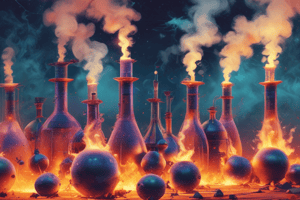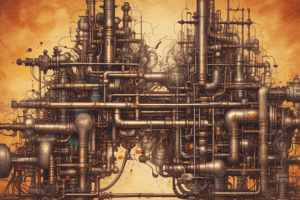Podcast
Questions and Answers
What is the significance of the Gibbs function of formation in thermodynamics?
What is the significance of the Gibbs function of formation in thermodynamics?
- It represents the change in Gibbs function for the formation of a compound from its elements. (correct)
- It measures the enthalpy change during a reaction.
- It indicates the specific heat capacity of a substance.
- It provides a direct measure of entropy in a system.
How is the Gibbs function calculated at a state other than the standard state?
How is the Gibbs function calculated at a state other than the standard state?
- By adding the specific Gibbs function change to the Gibbs function of formation. (correct)
- By integrating the entropy values of all components.
- By equating it with the overall energy balance of the system.
- By using the initial Gibbs function and applying a uniform pressure change.
In the context of chemical exergy, what does it represent?
In the context of chemical exergy, what does it represent?
- The energy released during spontaneous reactions.
- The measure of how far the composition of a system is from the reference environment. (correct)
- The total energy of all chemical components in a reaction.
- The maximum work obtainable from a system at equilibrium.
What role does temperature play in determining entropy values in EES code?
What role does temperature play in determining entropy values in EES code?
What is the relationship between mole fraction and unit issues in EES code?
What is the relationship between mole fraction and unit issues in EES code?
What is the correct representation of chemical exergy?
What is the correct representation of chemical exergy?
Which terms are used to calculate total exergy?
Which terms are used to calculate total exergy?
In the chemical formula CaHbOc, what do the subscripts a, b, and c represent?
In the chemical formula CaHbOc, what do the subscripts a, b, and c represent?
How can chemical exergy for a fuel be evaluated if specific properties are unknown?
How can chemical exergy for a fuel be evaluated if specific properties are unknown?
What does the y^e^ term represent in the context of chemical exergy?
What does the y^e^ term represent in the context of chemical exergy?
What is the role of the Gibbs function in simplifying chemical exergy calculations?
What is the role of the Gibbs function in simplifying chemical exergy calculations?
Which model is recommended for determining the standard chemical exergy for hydrocarbons in this course?
Which model is recommended for determining the standard chemical exergy for hydrocarbons in this course?
What is referred to as absolute entropy?
What is referred to as absolute entropy?
Which equation correctly describes the total mixture entropy for an ideal gas mixture?
Which equation correctly describes the total mixture entropy for an ideal gas mixture?
What is the significance of evaluating entropy in combustion processes?
What is the significance of evaluating entropy in combustion processes?
Which statement accurately describes the relationship between mole fraction and partial pressure in a gas mixture?
Which statement accurately describes the relationship between mole fraction and partial pressure in a gas mixture?
When calculating entropy production for a fuel at steady state, which variable represents the fuel?
When calculating entropy production for a fuel at steady state, which variable represents the fuel?
What characterizes the absolute entropy tables used for ideal gases?
What characterizes the absolute entropy tables used for ideal gases?
At what temperatures and pressures are the reactants considered for the combustion of liquid octane in the example provided?
At what temperatures and pressures are the reactants considered for the combustion of liquid octane in the example provided?
Entropy analysis in combustion is primarily concerned with which aspect?
Entropy analysis in combustion is primarily concerned with which aspect?
During combustion analysis, which condition is maintained as indicated in the example?
During combustion analysis, which condition is maintained as indicated in the example?
Which principle does the equation for partial pressure in a gas mixture rely on?
Which principle does the equation for partial pressure in a gas mixture rely on?
Flashcards
Gibbs Function
Gibbs Function
A thermodynamic property that measures the available energy to do useful work at constant temperature and pressure.
Gibbs Function of Formation
Gibbs Function of Formation
The change in Gibbs function for the reaction when a compound is formed from its elements in their standard state.
Gibbs Function in an Ideal Gas Mixture
Gibbs Function in an Ideal Gas Mixture
In an ideal gas mixture, the Gibbs function of each component is calculated at its partial pressure and the mixture temperature.
Chemical Exergy
Chemical Exergy
Signup and view all the flashcards
Exergy Reference Environment
Exergy Reference Environment
Signup and view all the flashcards
Chemical Exergy of Substance CaHbOc
Chemical Exergy of Substance CaHbOc
Signup and view all the flashcards
Standard Chemical Exergy
Standard Chemical Exergy
Signup and view all the flashcards
Chemical Formula CaHbOc
Chemical Formula CaHbOc
Signup and view all the flashcards
Reactants for Chemical Exergy Calculation
Reactants for Chemical Exergy Calculation
Signup and view all the flashcards
Mole Fraction in Environment (ye)
Mole Fraction in Environment (ye)
Signup and view all the flashcards
Absolute Entropy
Absolute Entropy
Signup and view all the flashcards
Partial Pressure
Partial Pressure
Signup and view all the flashcards
Mole Fraction
Mole Fraction
Signup and view all the flashcards
Entropy Production
Entropy Production
Signup and view all the flashcards
Exergy
Exergy
Signup and view all the flashcards
Exergetic Efficiency
Exergetic Efficiency
Signup and view all the flashcards
Steady State
Steady State
Signup and view all the flashcards
Burning
Burning
Signup and view all the flashcards
Complete Combustion
Complete Combustion
Signup and view all the flashcards
Theoretical Air
Theoretical Air
Signup and view all the flashcards
Study Notes
Combustion Supplemental Notes
- Combustion is the rapid oxidation of combustible elements in fuels, releasing energy in the form of combustion products.
- Three major combustible elements are carbon (C), hydrogen (H), and sulfur (S). Common examples include methane, ethane, and octane.
- Complete combustion occurs when all carbon is burned to carbon dioxide (CO2), all hydrogen is burned to water (H2O), and all sulfur is burned to sulfur dioxide (SO2). Incomplete combustion results in other products like CO, NOx, and other impurities.
- Oxygen is necessary for combustion, and air is commonly used as the oxygen source.
Modeling Combustion Air
- Dry air is often modeled as 21% oxygen (O2) and 79% nitrogen (N2) by moles.
- For every mole of oxygen used, air also supplies 3.76 moles of nitrogen.
- Nitrogen is considered inert in most combustion calculations.
- Molecular weight of dry air is approximately 28.97.
- In situations with moist air, water vapor content must be accounted for in combustion calculations.
Air-Fuel Ratio
- Air-fuel ratio (AF) is the ratio of the amount of air to the amount of fuel. It can be expressed on a molar or mass basis.
- Fuel-air ratio is the reciprocal of air-fuel ratio.
Step 1: Balancing Reactions
- Example: Complete combustion of methane (CH4) with oxygen (O2) yields carbon dioxide (CO2) and water (H2O).
- Balancing the reaction involves conserving the atoms of carbon, hydrogen, and oxygen.
- The balanced reaction equation for methane combustion is CH4 + 2O2 → CO2 + 2H2O
Theoretical Amount of Air
- Theoretical air is the minimum amount of air required to completely oxidize all the carbon, hydrogen, and sulfur in the fuel.
- Products of complete combustion with theoretical air are CO2, H2O, SO2, and nitrogen from the air.
- Often combustion uses more or less than the theoretical amount of air, commonly expressed as a percentage of theoretical air or as percentage of excess air (or deficiency).
Dry Product Analysis
- Often, combustion product analysis is reported as a dry basis. This means water is removed. Given this, percentages are for all products except water.
- Example problems demonstrate determining the balanced chemical reaction from the dry product analysis percentages.
Step 2: First Law Energy Balance of Reacting Systems
- Evaluate heat transfer rates during combustion reactions.
- Consider the enthalpy of the reactants and products for the energy balance.
- Calculations take into account kinetic and potential energy and use the ideal gas model.
Step 3: Evaluating Properties
- Combustion reactions are often modeled as ideal gas mixtures. Ideal gas mixture principles are used in determining internal energy, enthalpy, and entropy.
- Enthalpy of formation and absolute entropy are key concepts used when evaluating properties for reacting systems.
Heating Values of Hydrocarbon Fuels
- The heating value (HV) is the energy released when a fuel is burned completely, with the reactants and products at the same temperature and pressure.
- Higher Heating Value (HHV) accounts for water being in liquid form.
- Lower Heating Value (LHV) accounts for water being released as a vapor.
Adiabatic Flame Temperature
- Adiabatic flame temperature is the temperature of the products of a combustion reaction under adiabatic conditions (no heat transfer).
- Theoretical air amount is used to determine the maximum adiabatic flame temperature.
- Equations and EES problem-solving methods are shown to determine adiabatic flame temperature.
Chemical Exergy
- Chemical exergy measures how far a system's composition is from the exergy reference environment.
- Total exergy is the sum of thermochemical and chemical exergy in a reacting system.
- Equations are provided for calculating chemical exergy using the Gibbs function.
Absolute Entropy and the Third Law of Thermodynamics
- The third law of thermodynamics states that the entropy of a pure crystalline substance is zero at absolute zero temperature.
- Absolute entropy is the entropy of a substance relative to the entropy of a pure crystalline substance at absolute zero. This value is used for calculations.
Entropy Balance
- Entropy balance is used to determine entropy production during combustion reactions on a per mole basis.
- Equations are provided, along with example problems to guide the calculations.
Studying That Suits You
Use AI to generate personalized quizzes and flashcards to suit your learning preferences.





